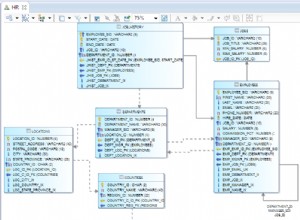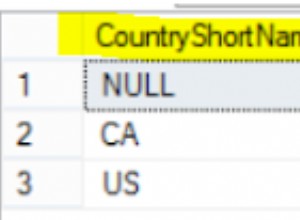Je ferais cela légèrement différemment en appliquant à la fois le UNPIVOT et le PIVOT fonctions pour obtenir le résultat final. Le unpivot prend les valeurs à la fois de totalcount et totalamount colonnes et les place dans une colonne avec plusieurs lignes. Vous pouvez ensuite pivoter sur ces résultats. :
select chardate,
Australia_totalcount as [Australia # of Transactions],
Australia_totalamount as [Australia Total $ Amount],
Austria_totalcount as [Austria # of Transactions],
Austria_totalamount as [Austria Total $ Amount]
from
(
select
numericmonth,
chardate,
country +'_'+col col,
value
from
(
select numericmonth,
country,
chardate,
cast(totalcount as numeric(10, 2)) totalcount,
cast(totalamount as numeric(10, 2)) totalamount
from mytransactions
) src
unpivot
(
value
for col in (totalcount, totalamount)
) unpiv
) s
pivot
(
sum(value)
for col in (Australia_totalcount, Australia_totalamount,
Austria_totalcount, Austria_totalamount)
) piv
order by numericmonth
Voir SQL Fiddle avec démo.
Si vous avez un nombre inconnu de country noms, vous pouvez utiliser le SQL dynamique :
DECLARE @cols AS NVARCHAR(MAX),
@colsName AS NVARCHAR(MAX),
@query AS NVARCHAR(MAX)
select @cols = STUFF((SELECT distinct ',' + QUOTENAME(country +'_'+c.col)
from mytransactions
cross apply
(
select 'TotalCount' col
union all
select 'TotalAmount'
) c
FOR XML PATH(''), TYPE
).value('.', 'NVARCHAR(MAX)')
,1,1,'')
select @colsName
= STUFF((SELECT distinct ', ' + QUOTENAME(country +'_'+c.col)
+' as ['
+ country + case when c.col = 'TotalCount' then ' # of Transactions]' else 'Total $ Amount]' end
from mytransactions
cross apply
(
select 'TotalCount' col
union all
select 'TotalAmount'
) c
FOR XML PATH(''), TYPE
).value('.', 'NVARCHAR(MAX)')
,1,1,'')
set @query
= 'SELECT chardate, ' + @colsName + '
from
(
select
numericmonth,
chardate,
country +''_''+col col,
value
from
(
select numericmonth,
country,
chardate,
cast(totalcount as numeric(10, 2)) totalcount,
cast(totalamount as numeric(10, 2)) totalamount
from mytransactions
) src
unpivot
(
value
for col in (totalcount, totalamount)
) unpiv
) s
pivot
(
sum(value)
for col in (' + @cols + ')
) p
order by numericmonth'
execute(@query)
Voir SQL Fiddle avec démo
Les deux donnent le résultat :
| CHARDATE | AUSTRALIA # OF TRANSACTIONS | AUSTRALIA TOTAL $ AMOUNT | AUSTRIA # OF TRANSACTIONS | AUSTRIA TOTAL $ AMOUNT |
--------------------------------------------------------------------------------------------------------------------------------------
| Jul-12 | 36 | 699.96 | 11 | 257.82 |
| Aug-12 | 44 | 1368.71 | 5 | 126.55 |
| Sep-12 | 52 | 1161.33 | 7 | 92.11 |
| Oct-12 | 50 | 1099.84 | 12 | 103.56 |
| Nov-12 | 38 | 1078.94 | 21 | 377.68 |
| Dec-12 | 63 | 1668.23 | 3 | 14.35 |




